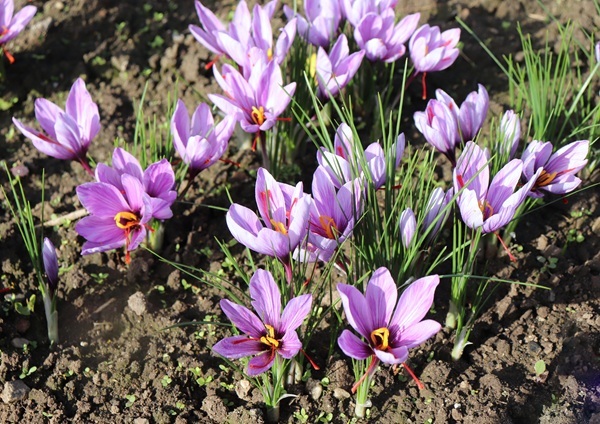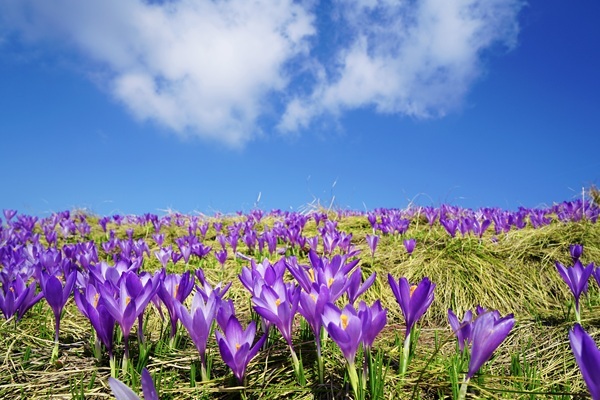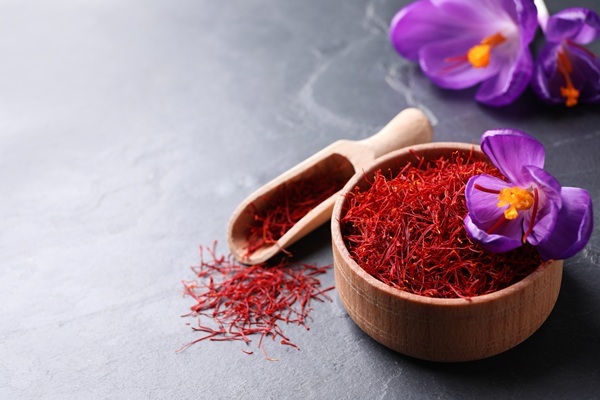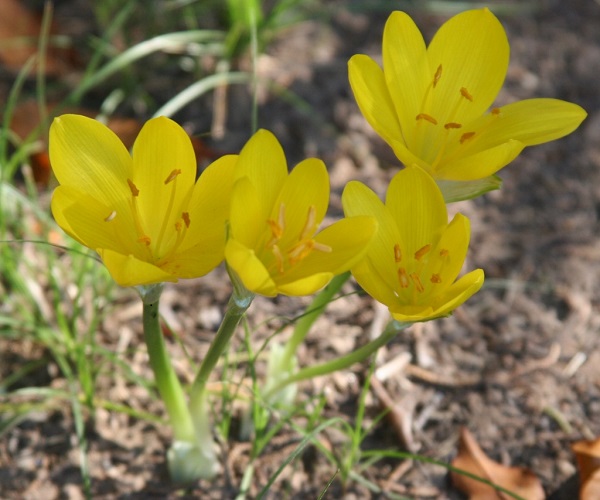

Delicate lavender blooms with glowing red stigmas — the source of the world’s most valuable spice! Each flower produces three crimson threads of saffron, treasured for their rich color and fragrance. These fall-blooming crocus appear just as most gardens are winding down, bringing a fresh burst of beauty to your beds or containers.

What to expect: You might see the foliage this January-May, but don't be concerned if you don't. The foliage dies down with the first warm weather in the spring. Most people still expect to see something growing during the summer months. You won't see anything. These bulbs are completely dormant in the summer. The flowers suddenly appear with the September rains. One day there is nothing growing and then suddenly you have a surprise, a fully blooming flower! These lovely little blooms act very similar to red spider lilies, yellow spider lilies, schoolhouse lilies, and naked ladies. Simply put, you won't see anything growing, then they suddenly bloom in the fall, and then they have foliage for the winter.
Think of it this way, you will never see a Crocus bloom with full green foliage. The bloom always sits on a naked stalk , with possibly some fresh foliage just beginning to appear at the base.

Care and planting: The Crocus "Saffron" acts so much like the Lycoris with its winter foliage and fall bloom. Plant in well-drained soil and partial to full sun (8 hours a day) so that you can enjoy blooms in October and November. Hardy in Zones 6–9, the saffron crocus multiplies over time, rewarding you with more flowers — and more saffron — each year. This bulb does great planted in clay, rocky, or sandy soil. It likes well-drained soil so you may even consider a slightly raised bed. Plant the bulbs with about 3-4 inches of soil above them. You might also plant the bulbs about 3-4 inches apart. Make sure that your bulbs don't get too much summer water. They like to be dry during the summer.
POTS: If you are going to plant this in a pot (which works great even in zones 4-5 - be sure to take extra care during the winter), be sure that the pot has good drainage, but really they really do best in the ground because of the winter foliage.

Sun: This is the most important part in the care and planting of the Crocus bulbs! Because the foliage appears AFTER the bloom, you need to be concerned with the winter sun. The foliage needs at least 6 hours a day of winter sun. Since we are concerned with the winter, consider more sun rather than less. You know how quickly good sunshine can melt a little bit of snow that falls in February whereas in the shade the snow seems to linger. When you look at the pictures, you notice that the blooms appear in everything from full sun to almost full shade. That's because the blooms, which appear in October/November, don't take in the nutrients so you can plant them under deciduous trees like live oaks or pecans where the bulbs can collect all of the winter sun they need.
Blooms: In October/November, after the fall rains begin, little bursts of lavender will pop out of the ground on naked stalks. Their bloom is only 4-6" tall, but they will draw one's eyes with their beauty when most bulbs are no longer blooming. The blooms look like little cups at first, and then they will open their petals wide to cover 2-3 inches. The bulbs bloom for a couple of weeks.

After the blooms: After the blooms die back, little tufts of foliage appear. The foliage often reminds people of "monkey grass," but be sure not to cut it as the bulb needs the nutrients that the foliage provides to get it through the summer. The foliage will die back around the beginning of May with the first warm weather of the year. Then the bulb is dormant until you see the bloom the next September.
FUN FACT: This is where the spice saffroon comes from. The World’s Most Expensive Spice – Saffron can sell for $500–$5,000 per pound, because it takes about 150 flowers to produce 1 gram of dried saffron threads!

Where have we seen it? In the fall, we often see red spider lilies. We see more and more Schoolhouse lilies, and we are even beginning to see more yellow spider lilies. But we don't often see the yellow Autumn daffodil (the yellow one above), and we rarely see the Crocus sativus "Saffron". It seems to prefer these clay and rocky soils where they can dry out in the summer. However, it also doesn't seem to mind the nice sandy loam soils of our farm, but we don't see much of it on the old home sites across East Texas.
It is a popular bulb for rock gardens with its low blooming habit and foliage that stays fairly well maintained. The 'Sternbergia' enjoys good drainage and slightly gravelly soil. Some areas where it can be found naturalized would be the heavy black land soils that tend to dry out and crack during the summer months. It has performed well for the Southern Bulb Company in slightly acidic sandy loam to slightly alkaline clay soils. For some, the yellow crocus-like bloom it produces in the fall is the closest they will ever come to a crocus in their garden.
Delicate lavender blooms with glowing red stigmas — the source of the world’s most valuable spice! Each flower produces three crimson threads of saffron, treasured for their rich color and fragrance. These fall-blooming crocus appear just as most gardens are winding down, bringing a fresh burst of beauty to your beds or containers.

What to expect: You might see the foliage this January-May, but don't be concerned if you don't. The foliage dies down with the first warm weather in the spring. Most people still expect to see something growing during the summer months. You won't see anything. These bulbs are completely dormant in the summer. The flowers suddenly appear with the September rains. One day there is nothing growing and then suddenly you have a surprise, a fully blooming flower! These lovely little blooms act very similar to red spider lilies, yellow spider lilies, schoolhouse lilies, and naked ladies. Simply put, you won't see anything growing, then they suddenly bloom in the fall, and then they have foliage for the winter.
Think of it this way, you will never see a Crocus bloom with full green foliage. The bloom always sits on a naked stalk , with possibly some fresh foliage just beginning to appear at the base.

Care and planting: The Crocus "Saffron" acts so much like the Lycoris with its winter foliage and fall bloom. Plant in well-drained soil and partial to full sun (8 hours a day) so that you can enjoy blooms in October and November. Hardy in Zones 6–9, the saffron crocus multiplies over time, rewarding you with more flowers — and more saffron — each year. This bulb does great planted in clay, rocky, or sandy soil. It likes well-drained soil so you may even consider a slightly raised bed. Plant the bulbs with about 3-4 inches of soil above them. You might also plant the bulbs about 3-4 inches apart. Make sure that your bulbs don't get too much summer water. They like to be dry during the summer.
POTS: If you are going to plant this in a pot (which works great even in zones 4-5 - be sure to take extra care during the winter), be sure that the pot has good drainage, but really they really do best in the ground because of the winter foliage.

Sun: This is the most important part in the care and planting of the Crocus bulbs! Because the foliage appears AFTER the bloom, you need to be concerned with the winter sun. The foliage needs at least 6 hours a day of winter sun. Since we are concerned with the winter, consider more sun rather than less. You know how quickly good sunshine can melt a little bit of snow that falls in February whereas in the shade the snow seems to linger. When you look at the pictures, you notice that the blooms appear in everything from full sun to almost full shade. That's because the blooms, which appear in October/November, don't take in the nutrients so you can plant them under deciduous trees like live oaks or pecans where the bulbs can collect all of the winter sun they need.
Blooms: In October/November, after the fall rains begin, little bursts of lavender will pop out of the ground on naked stalks. Their bloom is only 4-6" tall, but they will draw one's eyes with their beauty when most bulbs are no longer blooming. The blooms look like little cups at first, and then they will open their petals wide to cover 2-3 inches. The bulbs bloom for a couple of weeks.

After the blooms: After the blooms die back, little tufts of foliage appear. The foliage often reminds people of "monkey grass," but be sure not to cut it as the bulb needs the nutrients that the foliage provides to get it through the summer. The foliage will die back around the beginning of May with the first warm weather of the year. Then the bulb is dormant until you see the bloom the next September.
FUN FACT: This is where the spice saffroon comes from. The World’s Most Expensive Spice – Saffron can sell for $500–$5,000 per pound, because it takes about 150 flowers to produce 1 gram of dried saffron threads!

Where have we seen it? In the fall, we often see red spider lilies. We see more and more Schoolhouse lilies, and we are even beginning to see more yellow spider lilies. But we don't often see the yellow Autumn daffodil (the yellow one above), and we rarely see the Crocus sativus "Saffron". It seems to prefer these clay and rocky soils where they can dry out in the summer. However, it also doesn't seem to mind the nice sandy loam soils of our farm, but we don't see much of it on the old home sites across East Texas.
It is a popular bulb for rock gardens with its low blooming habit and foliage that stays fairly well maintained. The 'Sternbergia' enjoys good drainage and slightly gravelly soil. Some areas where it can be found naturalized would be the heavy black land soils that tend to dry out and crack during the summer months. It has performed well for the Southern Bulb Company in slightly acidic sandy loam to slightly alkaline clay soils. For some, the yellow crocus-like bloom it produces in the fall is the closest they will ever come to a crocus in their garden.